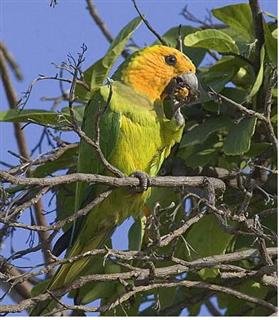Conure - Brown Throated
Brown Throat Conure Scientific Name: Aratinga pertinax aeruginosa
Wed, 27th November, 2024 - 9:33 pm GMT
Sponsor Ads:

Alternative Name
Brown Throat Conure Scientific Name: Aratinga pertinax aeruginosaBasic Info
Mature Brown Throated Conures average 10 inches (24 centimeters) in length. Though there are many subspecies, with different color variations, this subspecies has mostly green plumage. They differ from the St. Thomas Conure in that they have a narrow band to the forehead, that is a dark brown. The ring around the eye area is white, with the iris being yellow. The bill of the Brown Throated Conure is black. Immature Brown Throated Conures have a lighter color bill on top, and cheeks that are brown. The throat area, as well as the upper breast is usually an olive brown, with the still maturing birds having a green breast. Parts of the head are a yellowish orange, with the crown being blue. The lower breast has yellowish tints, with the abdomen turning orange. The tips of the primary feathers on the Brown Throated Conure are blue, and the underside of the wings range from an olive green to yellow, as does the underside of the tail. The feet are grey.
Health
When feeding Brown Throated Conures, it is always best to offer either a pellet diet or at least a fortified seed diet. As with most parrots, always offer them fresh fruits and vegetables, as well as foods such as beans and cooked eggs. Fresh water daily is necessary, as is removing fresh food quickly so it does not spoil. The Brown Throated Conure only needs a vitamin supplement if on a strictly seed diet. The size of the cage should be sufficient to accommodate their wings and room to play. Usually, an 18" by 18" by 22" wide cage will do, but bigger works well, too. A variety of perches is good exercise for the Brown Throated Conure's feet, and make sure the food dishes are not directly below a perch, so the food and water is not soiled. Breeding Breeding among the Brown Throated Conures usually happens between February and September. The female will need a nesting box, with good nesting material, cork being a good choice. Make sure the entrance hole in the box is about 3 inches in diameter. If your Brown Throated Conure is using the nestbox for sleeping, that is a good sign. They usually have to get used to it before laying an egg. The clutch will have from 3-6 eggs that incubate approximately 23 day. The young Conures usually fledge after 50 days. The young ones will sometimes stay with their parents, even after leaving the nest. Brown Throated Conures can have several clutches a year.Habitat
The Brown Throated Conure likes dry scrubland, including cactus and acacia trees as well as some tropical areas.Behavior
Brown Throated Conures are average sized Conures, and like other Conures, they are related to Macaws. Brown Throated Conures are intelligent, and both the male and the female are capable of speech. As is true with any parrot, there are never any guarantees that an individual will talk, regardless of whether or not they are a species that is known for speech. But among Conures, the Brown Throated Conure and its related subspecies are known for their ability to talk. This record deals with the subspecies Aratinga pertinax aeruginosa, though some other subspecies of Aratinga pertinax are also referred to as the Brown Throated Conure. Like the other subspecies, Brown Throated Conures may be very affectionate and loving pets if they are well socialized and handled frequently. Brown Throated Conures tend to form close bonds, but often they choose one member of the family to bond with rather than bonding with multiple people. The Brown Throated Conure may be very loud and can be prone to destructive behavior. They need to have plenty of toys to keep them from growing bored. Boredom is often the most common cause for destructive behavior. As with most Conures, the Brown Throated Conure loves to take a bath, and should be given clean bathing water and/or showers regularly. The Brown Throated Conure has an average lifespan of 10 years, though with proper care they can live to be 25.Origin
Northern ColumbiaHistory
Brown Throated Conures are native to Northern Colombia and Northwest Venezuela. They usually travel in pairs, but have known to congregate in groups of as many as a hundred. While feeding, some of the Conures will watch for danger and alert the rest of the flock.Common Foods
N/ASponsor Ads:
Grierson's Law of Minimal Self-Delusion: Every man nourishes within himself a secret plan for getting rich that will not work.
Conure - Brown Throated
Coded by: BGID® | ALL RIGHTS RESERVED Copyright © 2000-2024
Disclaimer | Privacy | Report Errors / Contact | Credits








 Homosexual behavior stems from the mind or genetics?
Homosexual behavior stems from the mind or genetics?  The Best Text Adventure You Will Ever Play! The official site:
The Best Text Adventure You Will Ever Play! The official site:  Why haven't we as a collective earth met with aliens yet?
Why haven't we as a collective earth met with aliens yet?  World EcoSystem - Biodiversity Changes - Who is on board and who isn
World EcoSystem - Biodiversity Changes - Who is on board and who isn  Mouthwash - Mouthrinse - Mouth Sores - Healing Infections - Gingivitis
Mouthwash - Mouthrinse - Mouth Sores - Healing Infections - Gingivitis  Treatment for Depression
Treatment for Depression  Ultra radical and violent Islamist group that even rivals Al Qaeda
Ultra radical and violent Islamist group that even rivals Al Qaeda  An idea to have teachers who want to carry guns to school undergo some level of police training will be left up to local school districts and police departments.
An idea to have teachers who want to carry guns to school undergo some level of police training will be left up to local school districts and police departments.